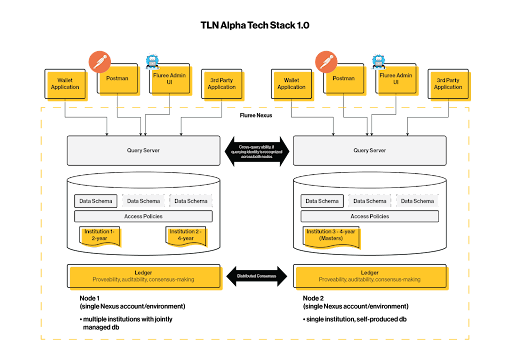Learner-centered technology: Designing the Trusted Learner Network’s alpha tech stack
Imagine a space where institutions and credential issuers could explore complex challenges and create new ways to record, curate and share achievements, long after the learner earns credits at an institution. This space is also where validated and immutable learner records can live, and the learner can curate those records and have greater control over the exchange of information amongst institutions, employers and more.
 This is the vision for the Trusted Learner Network, which requires a lot of thought as to how the technology is developed to allow this highly accessible and valuable system. Brooke Lipsitz, IT Product Manager for the TLN, recently shared the process of creating the TLN’s alpha tech stack, some of the challenges along the way and why keeping the learner at the center of this work is critical.
This is the vision for the Trusted Learner Network, which requires a lot of thought as to how the technology is developed to allow this highly accessible and valuable system. Brooke Lipsitz, IT Product Manager for the TLN, recently shared the process of creating the TLN’s alpha tech stack, some of the challenges along the way and why keeping the learner at the center of this work is critical.
For someone with no prior knowledge, what is a tech stack?
 Brooke Lipsitz (BL): Simply, a tech stack is made up of technologies gathered together, or stacked, to build and run an application or system.
Brooke Lipsitz (BL): Simply, a tech stack is made up of technologies gathered together, or stacked, to build and run an application or system.
A tech stack is similar to the foundation when developing a physical building for your business. First and foremost, you have a blueprint or design. Depending on your needs, the elements you use to build your tech stack will be unique to your project.
You’ll need to think about elements like a door on your building (security protocols), interior and exterior design (front- and back-end systems and protocols), a foundational frame (architectural framework) and more to create your tech stack.
One thing to consider about this analogy, though, is that the technologies in a tech stack don’t need to live in one physical space. There are so many operations related to a business that can be done outside of the actual physical building (think cloud-based services).
When you are building your “structure”, ask yourself: what does this place look like where you need to be able to conduct work and achieve your business goals?
How did you decide what technologies to include in the TLN alpha tech stack?
BL: The Architectural Advisory Committee helped us brainstorm and guide our technical decision making. It was important for us to include subject matter experts, especially those with experience in verifiable credentials (VCs), Learning and Employment Records (LERs), self-sovereign identity (SSI), and digital identifiers (DIDs). On top of that, our advisors have brought extensive architectural design knowledge, front- and backend systems development expertise, and computer science theory to the mix.
A good portion of what we’re building at the TLN is based around concepts that are still in development or freshly-minted best practices and specifications. That’s why it was important for us to have Architectural Advisors who could help us think through some of these concepts because it’s very much a “build-as-you-go” process.
As an overarching principle, interoperability is key — we want to be sure that the TLN can integrate with digital wallets, like Pocket, and other credit mobility tools.
Please walk us through the process of planning the alpha tech stack.
BL: Part of my initial work with the TLN involved establishing an Architecture Advisory Committee and Governing Body to drive and support TLN decision-making.
We began developing a regular meeting cadence with both groups around March and held our first major convening at the 2022 TLN Unconference. The 2022 TLN Unconference was an opportunity to engage in person, and during the event I facilitated working sessions with the Architecture Advisors and our development partner to help figure out what our alpha tech stack would be, how we were going to build it and what key components were required. This laid the foundation for the development process and plan for the future
Previously completing similar work with our development partner, and using lessons learned from the process, is what helped us build and make some key decisions around the alpha tech stack in such a short time frame.
We also knew we wanted to incorporate the following:
- We wanted to utilize immutable ledger technology (which is the ledger in the blueprint); by leaving an unchangeable record of every transaction or request to the TLN, this allows us to ensure the system is tamper-evident and enduring.
- We talked through different semantic standards and decided what programming languages would help facilitate future interoperability, such as adherence to VC standards and the utilization of React to create front end experiences.
- We wanted to utilize a graph database for the ability to scale and create an interoperable data schema.
We also knew the TLN needed to be a space to access data from multiple sources for a single user. Usually, when you request data, it’s a one-to-one relationship. The development of the alpha tech stack was based around this question: how can we have flexibility if we’re incorporating multiple participants with unique needs and extracting data from multiple places, while also centering its usage around a learner?
What were some of the challenges?
BL: The biggest challenges were parsing out what we could do now versus what required additional brainstorming and separating short-term versus long-term functionality.
There was pressure to get the alpha tech stack completed quickly, to enable feature builds. After the TLN Unconference, there were meetings and brainstorming sessions to develop mock-ups and strategically plan development as we came closer to a milestone deadline. For this kind of development, there’s no typical timeframe: what matters is that you have the necessary people in place to help guide the decision making and to brainstorm the key components and structure.
By having a solid, knowledgeable development team and support from the Architectural Advisory team, we were able to complete it by the deadline.
When determining this technology stack, why is it important to keep the learner central in all that you do?
BL: The alpha tech stack was built from the learner’s perspective — the learner has the ability to grant access to their records and revoke that access at any point in time. We’re essentially empowering learners to have more autonomy and access to their own data to facilitate movement within and outside of the ecosystem.
The reason why it’s important to keep the learner central to what we’re doing is because it aligns with our mission. Even though we’re utilizing new and emerging technology and trying to introduce these concepts about digital credentials and portability of records and data, we have a bigger mission around supporting the lifelong learner and realizing the power of placing achievements from multiple locations into a single destination. Learners need to have more options and flexibility demonstrating their accomplishments from a verified, trusted source.
What do you want people to know about the creation of the alpha tech stack?
BL: As much as it’s about the technology, it’s also completely not about the tech. It’s the value of the people you’re sharing space with as you talk through struggles and formulate ideas. You need a range of input to help you see your blind spots. It’s about this collaborative effort and getting people on the same page.
The key is that we’re in it for the long game. It’s not the alpha tech stack that makes this special, it’s how we’re engaging with incredible collaborators to involve everyone in this and figure out how to best serve the learner and incorporate them into the process.
Find out more about the principles of the Trusted Learner Network.